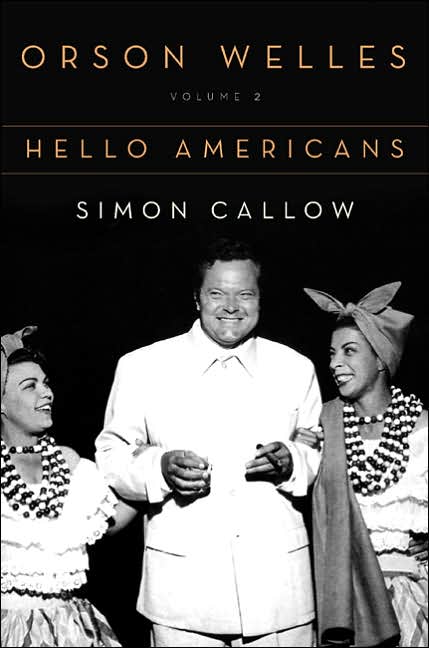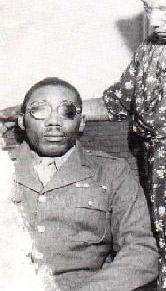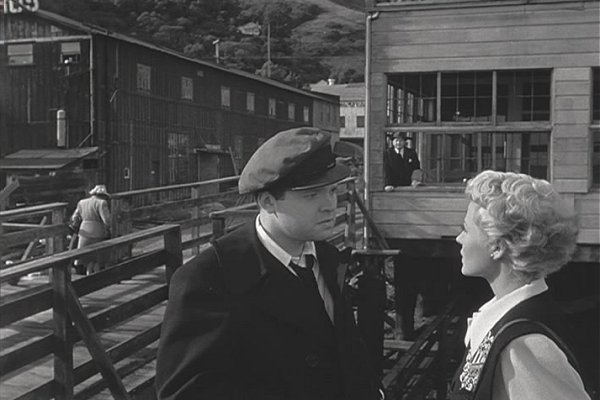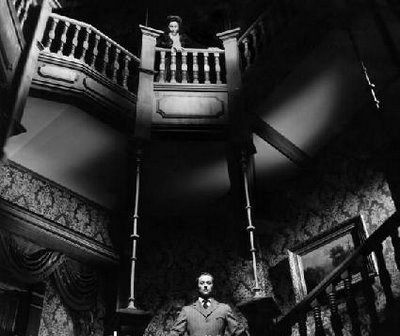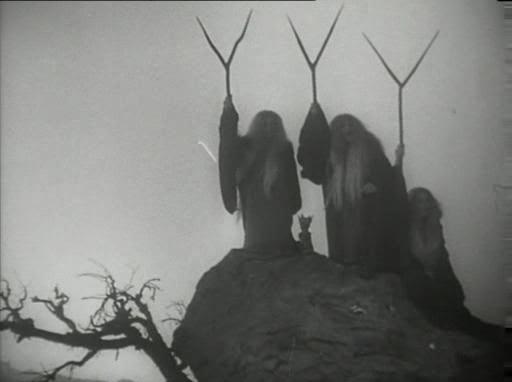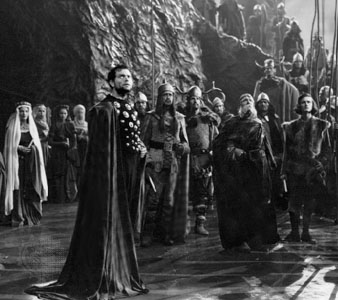From Cineaste (Fall 2006). — J.R.
Orson Welles: Volume 2: Hello Americans
by Simon Callow. New York: Viking Adult, 2006. 528 pp., illus. Hardcover: $32.95.
“It seems to me there is a plain, if many-layered, truth to be told,” Simon Callow writes in his Preface to the second volume of his Welles biography — noting his impatience with academics whose sense of the truth is so far from plain that they can only countenance the term between quotation marks. It’s an understandable position for him to take, but he doesn’t always stick to it himself, and it’s hard to see how he could. In his second chapter, he asserts that, although no evidence supports Welles’s claim that Booth Tarkington had been his father’s best friend, it doesn’t matter at all “one way or the other; what is significant is that Welles believed it to be true, and wanted it to be true, and his conception of [Eugene Morgan in The Magnificent Ambersons] is certainly an idealized version of his father.” In other words, Callow is privileging one kind of truth over another — like all of us who write about Welles, including those pesky academics. Like it or not, it comes with the territory.
Indeed, it’s no discredit to Callow to assert that he’s every bit as biased in Hello Americans as he was in his first volume, The Road to Xanadu, even though the nature of his slant has substantially changed. In fact, this is a far better book in the depth of its sympathetic understanding of Welles. Without ever discussing it, Callow has responded so well to criticisms regarding his first volume — notably his inadequate treatment of Welles’s leftist politics and some unwarranted slurs on his ethics, flaws that are in fact interconnected — that some of the most solid strengths here derive from his thoughtful and conscientious attention to these issues. Callow’s treatment of Welles’s period in Brazil, though likely to be superseded in some ways by Catherine Benamou’s forthcoming It’s All True: Orson Welles’s Pan-American Odyssey, is none the less the most lucid and comprehensive account we’ve had so far about this episode, written with a judicious sense of balance and fairness. And Callow is the first Welles biographer to tell the full story of Isaac Woodard, Jr., the black soldier blinded by a white sheriff in South Carolina in 1946 after he had an altercation with a bus driver, whose case became the major focus of Welles’s final American radio broadcasts.
Without ever becoming an uncritical partisan, Callow has learned how to take Welles more seriously, and his research, though unsystematic and far from exhaustive in some areas, is certainly extensive and packed with fresh information. Whatever quarrels one might have with some individual facts and interpretations (and I’m afraid that what follows in this review are mainly these), the overall portrait is rich and persuasive.
My point is that Callow is a superb writer — the best prose stylist who has ever written a Welles biography (including even David Thomson, whom he judiciously and justifiably passes over in silence) — and a very thoughtful analyst, especially of the art of acting. But he isn’t someone who has the ideal reflexes for a scholar, despite his tireless appetite for research. A scholar needs to hold some forms of judgment in at last temporary abeyance, but Callow’s fluency as a writer discourages such reticence; one can generally count on him to have a ready opinion on every subject regardless of whether or not he has the proper backup, so it takes a keen eye in some cases to determine how far he should be trusted. In most areas, he’s on solid ground, and his intelligence rarely lets him down, but his relative unfamiliarity with some aspects of Forties Hollywood occasionally trips him up.
The first volume, as Callow notes, “took 600 pages to cover Welles’s first 25 years,” adding that Welles was “professionally active” only for the last seven of these. Volume two spends 500 pages covering the next seven years, from the release of Citizen Kane to Welles’s departure for Europe after shooting Macbeth, his penultimate Hollywood feature. (How many more volumes are in store is apparently still to be decided, although it appears that just one is the present working hypothesis. Considering Callow’s exceptional access to Welles’s European coworkers in theater, volume three should add appreciably to what we know about Welles’s least researched work.)
Part of Callow’s bias in his first volume was that Welles treated his one-time business partner John Houseman cruelly and harshly. There appears to be some plausible basis for this judgment, but it lamentably led Callow to accept uncritically Houseman’s account of Welles’s capabilities and activities as a writer, overlooking the scholarship that has decisively refuted it, Robert Carringer’s “The Scripts of Citizen Kane” (a 1978 essay usefully reprinted in James Naremore’s recent casebook on the film — though much of its information is lamentably missing from Carringer’s own 1985 The Making of Citizen Kane). This essay concludes, “The full evidence reveals that Welles’s contributions to the Citizen Kane script were not only substantial but definitive,” thereby making hash of most other accounts of the script’s authorship, including Pauline Kael’s. (Craig Seligman’s mainly scrupulous Sontag and Kael concludes that “who wrote what” on the Kane script “is something we’ll never definitively know” — not at all true thanks to Carringer’s work, which clarifies much of who wrote what in all seven drafts.)
I can’t pretend that my own discovery of several uncredited coauthors of the screenplay of The Lady from Shanghai — recorded in both my notes to Welles and Peter Bogdanovich’s This Is Orson Welles and in the same book’s career summary — is definitive. For one thing, it’s probably an incomplete list. But I can at least report that this information was confirmed to me by the late Richard Wilson (one of the film’s two associate producers, and by far the most scholarly of all of Welles’s coworkers) shortly before his death. Yet perversely, after denying Welles his deserved credit as coauthor of the Kane script in volume one, Callow is happy in volume two to accept Welles’s undeserved credit as sole author of this later script — presumably because he hasn’t encountered my information, which he doesn’t try to refute.
Paradoxically, Callow’s greatest strength as a writer, his stylistic fluency, sometimes turns out to be his main liability because it can occasionally coax him into taking firm positions whose underpinnings haven’t been carefully worked out, despite the graceful confidence of his prose. A particular slippery slope relates to Welles’s compulsion to work on several projects at once and his frequent preference for process over finished products. These traits obviously played a role in some of the disasters that overtook Welles and his career, but it’s still important to recognize that the conditions attending each project were substantially different.
So it matters that Welles’s decision to fly to Rio after completing a rough cut of Ambersons with Robert Wise was predicated on an agreement that Wise would fly there later with this version so that Welles could do a final edit — a promise that for various reasons wasn’t kept. One could dispute whether Welles should have placed so much trust in this agreement, but acknowledging that it existed is a prerequisite for evaluating his behavior. Yet the closest Callow ever comes to acknowledging this is a passing remark that, after three days and nights of postproduction work with Welles at the Fleischer Cartoon Studio (in Miami), “Wise, in the hope that he might come to Rio at some later point [my italics], sped back to Hollywood with the rough-cut.” Based on my own research, including conversations with Wilson, I think Callow should have written “in the expectation that he would” instead.
This problem becomes compounded when Welles’s postproduction behavior on Macbeth is taken up. And in this case Callow’s incomplete grasp of another director’s work adds to the muddle. While surveying the “quality” productions of Herbert J. Yates at Republic, where Macbeth was made, he notes in passing that “in years to come Republic would produce two major John Ford movies, Rio Grande and The Quiet Man.” This omits The Sun Shines Bright, which, major or not, I and many others consider his greatest film (and was Ford’s own favorite) — even though, unlike the two mentioned, it has neither John Wayne nor any other star, one of its common points with Macbeth.
This could be called a minor oversight if it weren’t for the startling judgment that Callow makes nineteen pages later, while chastising Welles for fleeing to Europe before the postproduction work on Macbeth was done. The issue here isn’t the tactical wisdom of Welles’s behavior but Callow’s other assumptions. The passage in question, Chapter 21’s opening paragraph, should be quoted in full:
At this point Welles disappeared to Europe for a 25-year exile from which he would only return briefly and occasionally, leaving behind him a soundtrack and three weeks of loosely assembled footage. It was three years before the finished film would achieve anything like a general release, and when it did it was in such truncated and refashioned form that it was scarcely the film he had shot. Once again, his work had been confiscated from him. It is hard not to detect a pattern of sorts. Had he learned nothing from his absence from the postproduction process on The Magnificent Ambersons? He knew from bitter experience that long-distance, remote control editing was impossible, to say nothing of absence from the increasingly important preview period at which studio executives were prone to panic. With The Stranger he had ceded final cut in his contract; The Lady From Shanghai was always in Harry Cohn’s ruthless hands. But with Macbeth he was dealing with very different people. Yates was no monster in the Cohn/Spiegel mode, and Republic was not a palace of the Borgias, like RKO and Columbia, rife with schemers and counterschemers. At Republic Welles was admired, even revered, as Herbert Yates’s letter to him [quoted in the previous chapter] makes clear. He would certainly have been allowed and encouraged to make the cut he wanted. And yet he went. The student of Welles’s life feels like the audience at a melodrama: “Don’t go!” one wants to cry. “Finish the film!” But off our hero canters, oblivious to the destruction of his dreams.
It seems pertinent to point out that the nonscheming Yates cut ten minutes out of The Sun Shines Bright — a move that, far from making the film more commercial, made some parts of the plot unintelligible, and to all appearances was made rather brusquely and arbitrarily. (As Joseph McBride points out in his Ford biography, the full version became visible here only “when Republic inadvertently used it as a master for the 1990 videotape release.”)
More importantly, Callow’s account obfuscates the crucial information that Welles retained final cut over both versions of Macbeth and lost creative control over the second only to the extent that he was obliged to cut out two reels and redub the dialogue. These changes are far from minor, but they’re still a world apart from those imposed on the three other films cited by Callow, which entailed a complete loss of creative control. Welles undoubtedly alienated Yates and others at Republic by doing his editing abroad, but his studio contact in this case was Wilson (serving again as associate producer), his most trusted assistant. And it’s sheer fancy to imply here that if Welles had remained in the U.S., his first version of Macbeth, released in 1948, wouldn’t have been a critical and commercial disaster — eliciting scorn in such places as Life magazine and thereby occasioning Republic’s demand for the second version. Fortunately, Callow is aware of those early reviews, and his remaining account of Macbeth mainly doesn’t follow the implications of his opening paragraph (except to imply at times that the film was released only once). He seems to understand the situation better as he proceeds, to the point where he’s even willing to contradict his initial premises — but not to go back and revise them.
The final irony in all this is that Callow seems to share with Welles a certain impatience with finishing touches after having displayed tireless energy and resourcefulness. Happily, he’s able to educate himself on the job, but not always vigilant enough to catch his earlier gaffes. By the same token, he or someone else could have done more careful proofreading that would have eliminated such embarrassments as calling Welles’s last Hollywood feature A Touch of Evil on two separate occasions, misspelling such directors’ names as Endfield and Minnelli, or remarking that in 1943, Welles “had hardly been directed by anyone else in any medium” (an assertion ruling out his prolific and anonymous commercial radio acting in the Thirties that helped to finance many of the Mercury stage productions). He also might have done a better job in citing his sources; all too often I found myself paging forward to this book’s references to discover where some bit of information came from and not finding it. But despite all my quibbles, Hello Americans is a valuable and engrossing narrative about Welles’s middle years, and a sustained pleasure to read.

